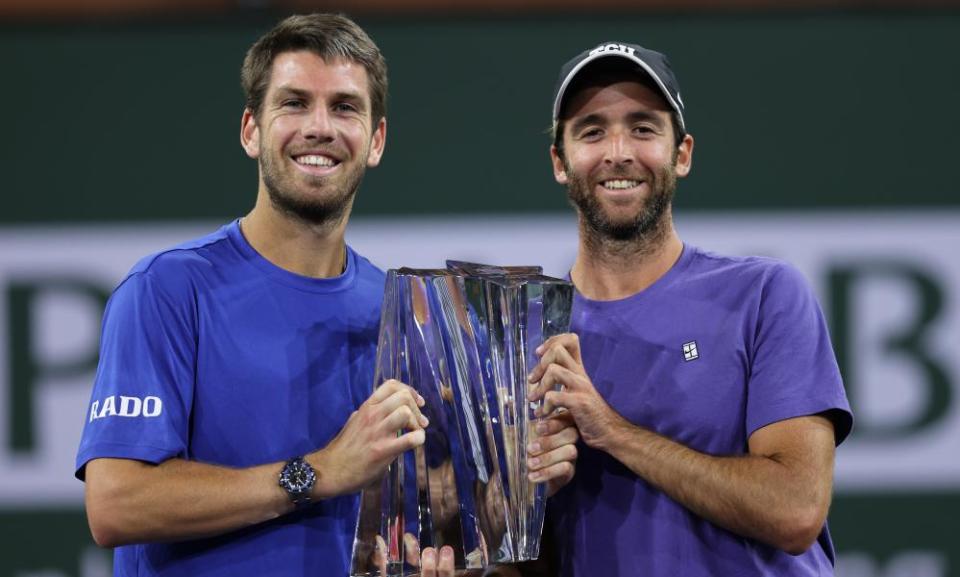Cameron Norrie backs up bravado to complete remarkable rise on court

At the beginning of the 2021 tennis season, numerous ATP tennis players were asked to predict the year ahead for a cutesy social media video. When it was Cameron Norrie’s turn, his response to who he thought would enjoy a breakthrough season was telling – himself.
As he now stands as the new British No 1, a top 20 player and a Masters 1000 champion, it is a small reminder of the confidence that he has carried with him up the rankings. While numerous experts and former professionals have admitted their surprise at his rise this year, Norrie’s ambition is stratospheric. He has constantly affirmed that his goal is to be No 1 in the world and he has already moved closer to it than most imagined.
One of the most interesting aspects of Norrie’s progression is how he has trodden his own unique path. Having reached the top 10 of the junior rankings, Norrie, who was born in South Africa and grew up in New Zealand before opting to represent Great Britain – the nationality of both parents – in 2013, chose to initially focus on building his game and character by competing in the NCAA at Texas Christian University.
Related: Indian Wells champion Cameron Norrie lost tennis shoes before final
It was at TCU where Norrie, 26, met his current coach, Facundo Lugones, a 29 year-old Argentine who soon became a good friend. Tennis players often prioritise the same experienced, established names when searching for a new coach. This partnership not only highlights the value of a close rapport between coach and charge, as they spend most hours of most days together around the world, but also what can come from trusting young, ambitious coaches who are as desperate to learn and establish themselves as the player is.
“I try to give my best because I know I need to get better at a lot of things,” said Lugones on Sunday. “I don’t have the experience other coaches or former players have. So I need to work harder than everyone to make sure I can deliver what Cam wants and what he needs. I always have that chip on my shoulder to do a little bit extra.”
Although Norrie’s rise has been fuelled by a culmination of experience and growth, Lugones pinpoints a recent evolution which has seen him “taking ownership” of all parts of his career, both on and off the court.
There have been no spectacular changes to Norrie’s game, but he has improved in almost all areas. His far more consistent, relentless returning has yielded a rate of 26.1% of return games this year, a monumental rise from 20.3% in 2019. Norrie’s serve has also subtly improved, offering more opportunities to end points on his second shot.

His forehand, previously vulnerable to dropping short under sustained pressure due to an elaborate backswing, has been upgraded defensively and has enabled Norrie to become far more adept at dictating points. The stark contrast between his spinny, high-bouncing forehand and one of the flattest backhands in the sport is now even trickier for opponents to handle.
And then there is his supreme physicality, which has only improved since the pandemic hiatus when he spent weeks away from the courts running around New Zealand and posting absurd times across various distances on Instagram.
One of the ways that Norrie has always stood out is how he talks about the defensive aspect of his game. Norrie clearly takes great pride in the knowledge that he can physically break down so many of his opponents and draw a stream of errors due to his consistency.
In his fourth-round match at Indian Wells against another supreme athlete, he relished the attritional battles with Roberto Bautista Agut as he clinched a brutal 6-4, 5-7, 6-3 win. He also stressed the importance of smothering Grigor Dimitrov’s single-handed backhand in the semi-final and testing Nikoloz Basilashvili’s questionable rally tolerance by lengthening the exchanges in the final.
The fact he is now champion of the fifth biggest regular tournament in the world, after a season in which he has performed at a high level week after week for the most of its 10 months, proves that his approach is paying off handsomely.

 Yahoo Movies
Yahoo Movies 